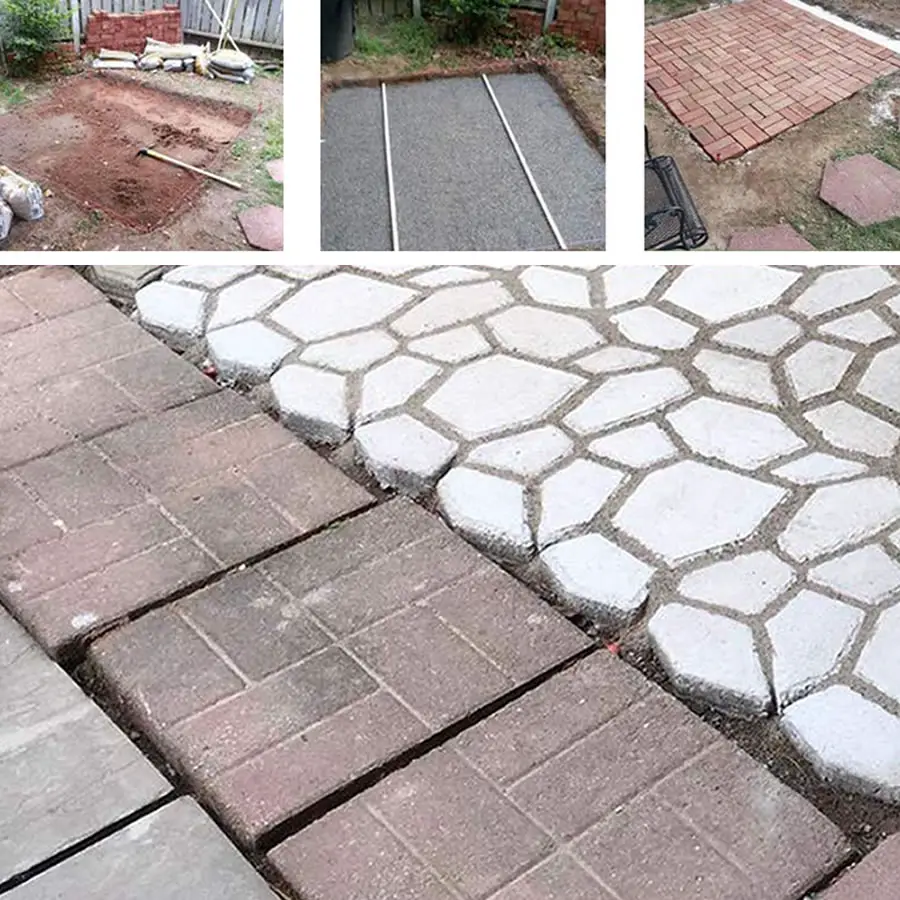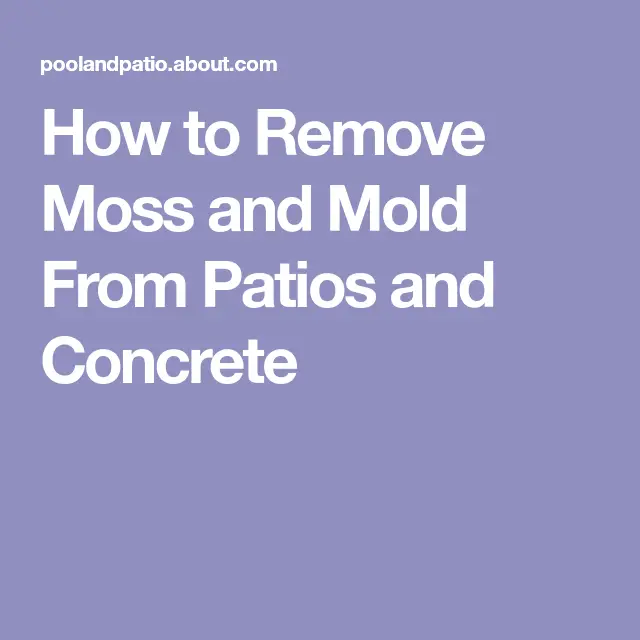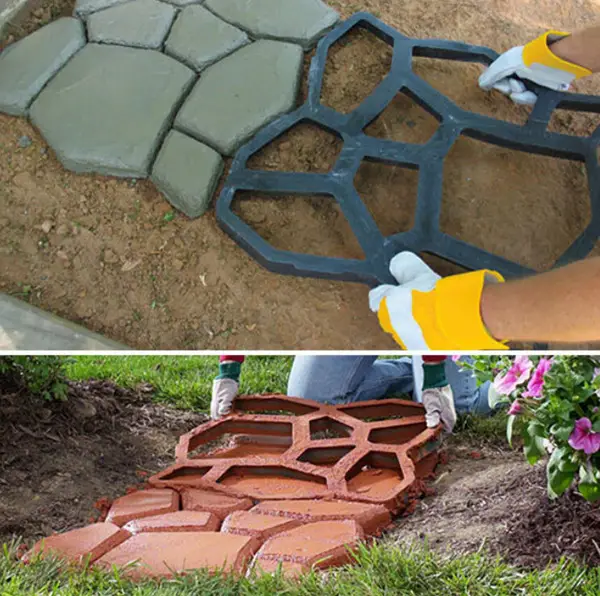I Have A Major Moisture Issue Along One Wall In Basement Particularly Behind Furnace Duct
The white, fluffy substance is efflorescence and the black spotting on the wall is mold growth. Efflorescence occurs when moisture moves through the concrete and deposits minerals/salts on the surface. In a basement, this can be a complex issue. First, I recommend looking at your downspouts and ensure they are moving the water far away from your home. Your goal is to reduce the moisture load in the soil near your home.
If this doesnt solve the problem, youll likely need a sump pump and possibly an interior footing drain. While expensive, they are often the only way to completely solve the problem. In most cases this will involved removing the wall in the problem area so the footing drain can be installed at the very edge of the concrete slab.
Will Vinegar Remove Oil From Concrete
Yes, cleaning concrete with vinegar will remove oil from concrete. You wouldnt believe it, but if youve had an oil spill in your garage, it will work.
Vinegar will remove mild oil stains from concrete. You might be able to remove even the deepest oil stains if you mix vinegar with dish or laundry soap.
To do this, mix half a cup of vinegar with soap and water. Pour the mixture onto the concrete and sprinkle it with sawdust. The sawdust will absorb the oil, and you can wipe the oil and sawdust carefully away after all of the oil has been absorbed. This will take about 30 minutes for unfinished concrete.
How does this work? The vinegar eats away at the cement in the concrete that binds its molecules together. The oil gets leached out of the concrete and absorbed by the sawdust so that when you sweep it away, most of the oil will be removed. Be careful not to sweep the dirty sawdust onto your clean concrete, or youll be cleaning that with vinegar next!
How Do I Remove Mold From Concrete
Thankfully, because of the extreme durability of concrete, removing mold growth is a relatively simple process. Unlike sheet rock, framing or carpeting, you dont need to worry about damaging the underlying material.
If its a large area, a professional should perform the remediation. Theyll setup containment and HEPA filtration to ensure the spores dont spread throughout your home during the cleanup process. If the area is relatively small, you can likely tackle it yourself.
The removal process typically requires the use of both a fungicide and physical removal of the mold. The fungicide will deactivate and kill the mold spores, but staining and discoloration will likely remain. This is often addressed with HEPA vacuuming, scrubbing, steam cleaning, sandblasting, etc. In large commercial settings, dry ice blasting is occasionally used to remove mold from concrete.
A note about expectations
While cleaning the active growth from the concrete is relatively straightforward, some staining will often remain. This is especially true when dealing with black mold growth. The pigment left behind by the growth can be difficult to remove. Its important to remember, this staining is not a health hazard, nor can it regrow. Its simply a byproduct of the original growth. If the discoloration remains after the initial cleaning, paint the concrete with a stain blocking concrete primer.
Also Check: How Much Does Mold Removal Cost
Homemade Mold Remover Spray Recipes
Use the spray suggested for the type of surface youre cleaning. Do not use these sprays at the same time or immediately after each other since their ingredients should not be combined. Do not store unused portions theyll lose effectiveness after 2-3 hours. Keep the sprays away from children and pets, and use proper ventilation at all times.
You May Like: Remove Mold From Bathroom Ceiling
Cleaning Mold Off Unsealed Drywall

Unfortunately, its not so easy to clean mold off unsealed drywall. Drywall is porous, which means the mold may be visible on the surface, but its also growing inside the pores. Without water-resistant paint, its very likely that by the time you notice the mold, its already inside the drywall too. You can look for mold by cutting inspections holes into the drywall. Remove the insulation and use a mirror to inspect the other side of the drywall.
If mold is growing on the insulation, it will need to be removed and replaced. Likewise, if you find that your drywall has mold beneath the surface, you will need to remove and replace it as well.
Unless youre trained in mold remediation, the most you can do is temporarily reduce the overall mold growth by using a mold removing cleaner and scrubbing the visible mold away. You will need to contact your local mold experts for an inspection to discover the full scope of your mold damage. Even if you clean away all the mold, if it still has a source and some mold remains, it will continue to grow back.
Don’t Miss: How To Remove Black Mold Naturally
Use Bleach To Remove Mold
The bleach solution is powerful in getting rid of surface stains, algae on the paver patio, mold, and concrete.
Before you begin to use this bleaching solution, you need to make sure that no adjacent grass and plants may get affected by the bleaching solution.
It is important to note that this bleaching solution can cause dizziness if inhaled and irritate your skin. Therefore, it is crucial to put on protective gear.
To use this bleaching solution method, follow this step-by-step guide:
The Result Of Cleaning Concrete With Algae Cleaner
The algae cleaner did remove some of the algae but there was still a lot left behind. To be fair, the instructions recommended repeating the process a couple more times until all the algae disappeared. We just weren’t happy with spraying our whole patio with dangerous chemicals multiple times just to get these old patio stones clean.
You May Like: How Long Does It Take For Black Mold To Form
Why Does Mold Grow On Concrete
Moisture. This is the one variable we can control when dealing with mold. With concrete you have 3 primary avenues for excess moisture.
Liquid water intrusion
If any part of your home is below grade, youve essentially created a giant empty bowl surrounded by water. Without proper drainage and/or a sump pump, the water will eventually make it through the concrete. Large cracks or holes are not necessary. Hydrostatic pressure is quite powerful and can force large amounts of water through hairlines cracks. Liquid water intrusions certainly can cause mold growth, however it is usually quite localized.
Mold growing on concrete beneath failed waterproofing
Humidity based mold growth
Concrete is a poor insulator. During the winter months when the temperature drops, the cool surface of a concrete wall can cause condensation. In time this elevated surface moisture creates an environment conducive to mold growth.
Mold growth on concrete due to humidity is typically diffuse and spread across a large area.
Mold growth on a concrete wall due to excess humidity.
On its own, concrete does not provide a sufficient food source for fungal growth. Unfortunately this is not especially helpful, because like almost anywhere in a building, dust quickly accumulates on the surface. Within this layer of dust large quantities of food sources for mold are present. Therefore, unless the concrete is kept extremely clean, mold growth can occur.
What Is White Mold
White mold is often found in cool, damp environments such as in basements on walls and other structures. It is often confused with efflorescence, which is a mineral deposit that forms on foundation walls and other masonry surfaces due to water seepage. You can test to see if its mold by spraying it with water. If it dissolves, it is a mineral deposit if it does not, then its most likely white mold.
Don’t Miss: How To Clean Black Mold In Bathroom
Best Way To Clean A Concrete Patio With A Pressure Washer
I have to say, the pressure washer was a complete game-changer. The paint stains, grease stains, mold, and all other types of stains completely disappeared after power washing.
I’m not sure if this would work on all types of concrete flooring but we did try it out on our concrete garage floor and had the same success there too.
I should point out here that we do not have any type of concrete sealant on our garage floor. The exterior concrete in the garage is going to be tiled eventually. We just wanted to try out the pressure washer on the garage floor to see if it would remove the oil and grease stains.
Remove Loose Dirt And Debris
Sweep or vacuum loose dirt off the surface of your concrete, with one exception: if you have a mold or mildew problem. in your basement. Follow the instructions below for tackling these potential household toxins.
If you are cleaning a patio or driveway, remove and treat any weeds that may have infiltrated cracks.
Read Also: How To Remove Mold From Hvac Ducts
Seven: Vacuum Or Sweep The Patio
Mopping will remove most of the dislodged mold, but there will surely be some leftover particles on the ground. To remove them, simply do a thorough vacuum across the patio to suck up any bits and pieces left.
You can also use a broom to sweep the dead mold leftovers away. Although you have to control the sweep towards the direction of the dustpan. Reckless sweeping may spread the dead mold to other areas.
Remember, dead mold is also hazardous, so youd want to get rid of them from your yard as a whole.
After the vacuum or sweep, dispose of the particles by emptying them in your outdoor trash bin and youre done!
Your patio is now free of mold and you can enjoy hanging out there with your family, friends, and pets!
Tips For Preventing Mold On Walls

The most effective way to prevent mold and mildew from growing on your walls is to control moisture in your property. You can minimize the humidity within your home by using a dehumidifier and ensuring all rooms are well ventilated.
Condensation can also cause mold in your home. However, you can help to prevent it by insulating roofs, windows, exterior walls, and pipes.
Bathrooms and kitchens are particularly prone to mold and mildew. Ensure that these rooms are cleaned regularly to prevent spores from growing.
Recommended Reading: How To Get Rid Of Mold In My Apartment
Also Check: How To Tell If Mold Is Toxic Black Mold
What Kills Mold On Pavers
There are various factors or products that can kill mold on concrete and paver patio.
For instance, you can kill mold on pavers by exposing the pavers to sufficient sunlight. Direct sunlight rays dry the moisture and water on the concrete and paver.
However, it is critical to note that, for either of these methods to be successful, you need to follow the step-by-step guide of each.
Therefore, you will need to understand how to perform each method to adequately kill the mold on the concrete and paver patio, bricks, cracks, and stones.
Use A Pressure Washer To Get Rid Of Mold
The hot water pressure washer is a super ideal method that you can use to get rid of and remove the stubborn mold. Once you remove the dirt and other debris, you will be required to blast mold using hot water. To do this, you will need a power washer.
Hot water assists in killing fungi cells and other stubborn microorganisms. However, it is essential to be careful while using this method, especially in situations where other plants are present in the surrounding patio.
Once you have splashed the hot water, you will realize that the stubborn and sticky mold has become soft. As such, you will then be able to scrub the mold using a deck brush.
Besides, you can use a steam cleaner to kill the mold on hard surfaces.
Finalize this by replenishing the patio joint that your powerful jet water may have displaced.
Also Check: How To Remove Mold From Washer Gasket
How To Get Rid Of Basement Mold
There are numerous ways to get rid of mold in your home and basement. However, before you start clearing out the mold, make sure you fix the real problem as the mold growth is only a symptom of an underlying problem. This could mean fixing a leak, ensuring that the basement has proper ventilation, and checking that any standing water has dried.
Here are several methods you can use to remove mold from your home and basement.
Recommended Reading: How To Get Mildew Off Bathroom Ceiling
Looking For More Helpful Tips To Keep Your Home Mold Free
Do you want more information to remove mold from concrete and other areas? If youre dealing with mold or water damage, check out our blog. We have tips and resources to help you.
But if the problem is bad and you need a professional, contact us here. Well do whatever it takes to get your home mold free.
Read Also: Can Black Mold Cause Rashes
How To Clean Mold Off Outdoor Cushions
Outdoor cushions bring indoor comfort to outdoor spaces, but there’s a downside: These materials can be prone to mold and mildew. It’s important to invest in cushions and fabric that are not just easy to clean but are engineered to resist water, mold, and mildew from the start, says Sarah Dooley, marketing director of upholstery at Sunbrella.
Why Does My New Concrete Have Dark Spots
Calcium chloride in concrete is a primary cause of concrete discoloration. The resulting low water- cement ratio affects the hydration of the cement ferrites, which contributes to a darker color. Concrete surfaces that are troweled too early will increase the water- cement ratio at the surface and lighten the color.
Read Also: Can You Get Rid Of Mold In Your House
Banish Mold Infestations With Professional Help
What gets rid of black mold? Most of the cleaners weve mentioned can snuff out black mold infestations, but we recommend getting professional help for significant black mold growth. This is because Stachybotrys chartarum, or black mold, can be harmful if breathed in large quantities.
If a basement mold problem is really severe, mold removal specialists might turn to fumigation to eradicate the infestation. Whichever method they choose to take care of your mold problem, you can rest assured that a professional will do a thorough job to prevent the black mold areas from returning.
If you dont eradicate the source of the moisture that caused the mold, you could see more mold, but a professional will eradicate all mold spores and roots from an infestation so that the same colony cannot grow back, particularly in the same area.
Dehumidifiers and waterproofing paint can be useful for helping to stave off future mold issues. Wet, moldy surfaces like carpeting and drywall are often too far gone to be salvaged and need a replacement instead.
Water Stains Mold And Mildew

Cleaning concrete floors in a basement that is has a mold or mildew problem is different from cleaning a concrete patio with the same issue. If you have a mold or mildew problem on your basement floor, do not sweep the areayoull end up spreading mold spores around the basement, causing a much bigger problem.
Open any windows and allow fresh air to circulate while cleaning. Spray the problem area with a solution of mold-killing detergent and water , scrub the area with a brush, and rinse with a clean wet mop.
Once the area is completely dry, examine it to determine if you need to repeat the process.
To remove water, mold, or mildew stains from concrete patios and driveways, use a hose or pressure washer. If stains persist, mix a solution of one-quarter bleach to one gallon of hot water and scrub the area with a brush, watering down nearby foliage first to prevent damage from runoff. Rinse thoroughly with clean water.
Also Check: Mold And Skin Rash
You May Like: What Are The Symptoms Of Having Mold In Your House
How Long Before An Orange Fruit Gets Mold
It should be two to four weeks in the vegetable crisper drawer before you notice any decrease in fruit quality or mold formation. At the first signs of mold, discard the fruit, regardless of how long it has been stored. Pre-sliced oranges will last up to two days in the refrigerator in a covered container.
Tips To Keep Your Patio Clean Longer
For those who followed the instructions, scrubbed hard, and used the solution a few times without much luck, know that sometimes tougher measures are called for. A product like Wet & Forget should do the job. While the label says it is bleach-free, phosphate-free, non-acidic, and safe near plants and on all outdoor surfaces , do take caution when using this product. Wear rubber gloves and avoid unnecessary dripping into your garden or grass.
Follow the directions on the container of the cleaning product, making sure that the previous cleaning solvents have been thoroughly rinsed off with a strong blast from the hose. While the product used may claim that scrubbing isn’t necessary, it will probably be necessary to have those sleeves rolled up continue to scrub the moldy/mossy area until it’s free of all the green stuff.
Try revisiting the area in a week or two to keep on top of the mold and mildew. Persistence will pay offâif you regularly do a light cleaning of the space, more thorough cleanings every few months won’t be necessary.
Recommended Reading: How To Make Your Own Resin Molds
